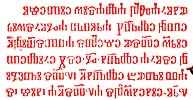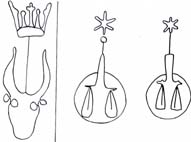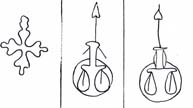TITLE PAGE
INTRODUCTION
GLAGOLITIC PAST
1483 MISSAL
BIBLIOGRAPHY
Incipit page of 1483 Missal (Badalić 1952, pl. 27).
Sketches of paper watermarks from various copies of the 1483 Missal (Bošnjak et al. 1963, p. 27).
Sketches of paper watermarks from various copies of the 1483 Missal (Bošnjak et al. 1963, p. 28).
PHYSICAL DESCRIPTION
None of the extant copies of the 1483 Missal are complete, but some of them are in fairly good condition so that by the collation of all copies it was possible to reconstruct the original structure of the book.
The Missal is printed on folio format paper (ca. 27 x 18 cm). Although most of the copies are printed on the paper, some preserved fragments are printed on parchment. Because each of the fragments belongs to different parts of the book, it is most probable that the some copies of the edition were printed on the parchment, rather than just strengthened with parchment interlay (Nazor 1993, p. 230).
The Missal would originally have 28 gatherings of 220 leafs. The last leaf was not preserved in any of the extant copies, but was probably blank. The first and last gathering have 6 leafs, while remaining 26 have 8 leafs. The first 6 pages with calendar do not have any pagination. The quires with text are marked in lower right corner under the last line of text on the recto size of the first 4 leaves. The signatures were marked with the Glagolitic letters (a, b, c …) and each of four leafs in quire with vertical lines (a|, a||, a||| and a||||). The letters follow alphabetic order of the Glagolitic script, except that letter F (between U and H) is omitted (Krader 1996, p. 63) .
The text of calendar is printed in one column, width of the paper. The rest of text is printed in two 36-line columns with type in three sizes (bigger, smaller and initial). Texts is printed in red and black ink. The body of text was printed in black, while certain holidays, rubrics, various symbols and nomina sacra were printed in red ink. The space in the height of two, three or four lines was left empty for pericope initials. This initials were never printed, but in some copies, they are added in by hand and occasionally colored in red ink. Some of the initials (notably Washington copy) were decorated initials in the manuscript style with floral motifs.
The page facing the Canon (quire n|) was left empty for the illustration of the Crucifixion. Only three extant copies—in Vienna, St. Petersburg and Washington—have illustrations preserved. The hand colored woodcuts are glued on the empty page and each print is different, suggesting that they were added by the users in some latter time.
In the year 1963 group of the Croatian experts analyzed the watermarks of the number Croatian incunabula. In the case of the 1483 Missal, it was find that most common watermarks on the Missal’s paper are: a bull’s head with a crown, scales (in five different variations) and a Greek cross. The two-thirds of papers in the examined copies have watermark with a bull’s head. According to this research, the paper most probably come from the paper mills in Germany. However, source of the paper is by no means indicatior where book is printed. Printers rarely bought paper directly from the paper mill and paper from established paper centers traveled all over Europe. Most of the paper mills supply their paper to paper dealers who would then sell paper according to the paper quality, thickness or color rather than place of origin (Bošnjak 1963)
In 1971, the copy of the 1483 Missal, collated from the copies held in the National and University Library in Zagreb, and the Vatican Library was republished (Missal po zakonu rimskoga dvora [1483], LC number BX2015.A5 R6 1971). The reprint is appended with the research and technical analysis of the Missal written by various authors.
 PRINTING
PRINTING
 TEXT
TEXT
 TYPOGRAPHY
TYPOGRAPHY
 BINDING
BINDING
 COPIES
COPIES

Bibliography
Bošnjak, M. et al. (1963). Vodeni znakovi hrvatskih inkunabula. Bulletin Zavoda za likovne umjetnosti JAZU, XI(3), 20-50.
Krader, B. (1963). The Glagolitic Missal of 1483. The Library of Congress Quarterly Journal of Current Acquisitions, 20(2), 93-98.
Nazor, A. (1993). Hrvatskoglagoljske inkunabule. U povodu 500. obljetnice brevijara Blaža Baromića (1493-1993). Croatica. Prinosi proučavanju hrvatske književnosti, XXIII/XXIV(37/38/39).
Written by Vlasta Radan.
Last update April 10, 2006.


